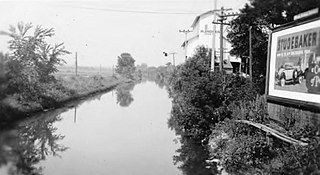
Old Oakland is a historic district in downtown Oakland, California. The area is located on the northwest side of Broadway, between the City Center complex and the Jack London Square district, and across Broadway from Chinatown.

U.S. Route 66 was a United States Numbered Highway in Illinois that connected St. Louis, Missouri, and Chicago, Illinois. The highway had previously been Illinois Route 4 (IL 4) and the road has now been largely replaced with Interstate 55 (I-55). Parts of the road still carry traffic and six separate portions of the roadbed have been listed on the National Register of Historic Places.

The Peoria Marriott Pere Marquette, is a historic 14-story hotel in downtown Peoria, Illinois, United States. Built in 1926, the building is Peoria's only surviving example of an upscale 1920s hotel. It was listed on the National Register of Historic Places in 1982.

The Carling, formerly known as the Carling Hotel and Hotel Roosevelt, is a historic building in Jacksonville, Florida, United States built in 1925. It is located at 31 West Adams Street in Downtown Jacksonville. As its former names indicates it was originally a hotel, and was used for that purpose until 1964; it currently serves as a residential building.

Central House is an 1860s hotel building located in the 800-person village of Orangeville, in Stephenson County, Illinois, United States. The building was built by Orangeville founder John Bower and operated as a hotel from its construction until the 1930s, when it was converted for use as a single family residence. The three-story building was the first commercial brick structure in downtown Orangeville. Architecturally, the building is cast in a mid-19th-century Italianate style. Central House was added to the U.S. National Register of Historic Places in 1999.

The Heathman Hotel, in Portland, Oregon, United States, was originally built as the New Heathman Hotel and opened in 1927. It is among the last remaining historical Portland hotels such as the Benson Hotel, Imperial Hotel, and Governor Hotel. The Heathman Hotel is a member of Historic Hotels of America, the official program of the National Trust for Historic Preservation. It was listed on the National Register of Historic Places in 1984, as the New Heathman Hotel.

The Plano Hotel is a 19th-century hotel building located in Plano, Illinois, United States. It was built in 1868 by John K. Smith and reflects the Italianate architectural style. In 1993, the building was added to the U.S. National Register of Historic Places.
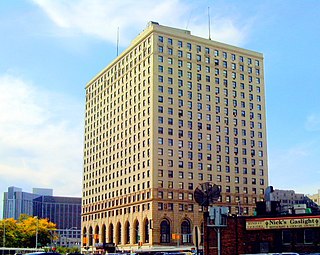
The Detroit-Leland Hotel is a historic hotel located at 400 Bagley Street in Downtown Detroit, Michigan. It is the oldest continuously operating hotel in downtown Detroit, and was listed on the National Register of Historic Places in 2005. The ballroom of the Detroit-Leland has hosted a nightclub, the City Club, since 1983. The hotel is now named The Leland and no longer rents to overnight guests.

The Whittier is a partially renovated high rise residential complex and former hotel located at 415 Burns Drive in Detroit, Michigan, on the Detroit River. It was listed on the National Register of Historic Places in 1985.

Downtown Hartford, Connecticut is the primary business district and the center of Connecticut's state government. Due to the large number of insurance companies headquartered downtown, Hartford is known as the "Insurance Capital of the World".
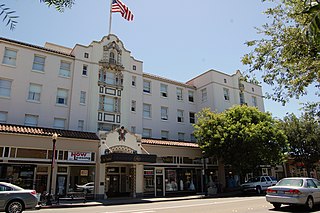
Hotel Woodland is a historic hotel located in Woodland, California and designed by William Henry Weeks. The hotel is on the National Register of Historic Places, and is a contributing property of the Downtown Woodland Historic District.
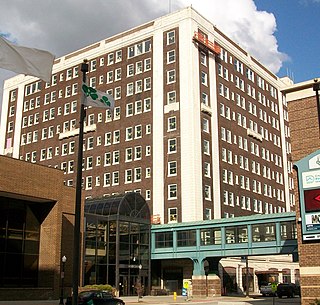
The Hotel Blackhawk is an eleven-story brick and terra cotta building located in Downtown Davenport, Iowa, United States. It is a Marriott Autograph Collection property and it is a member of Historic Hotels of America, the official program of the National Trust for Historic Preservation.

The Milk Pail Restaurant, formerly known as the Country Tea Room, is a historic restaurant (tearoom) in unincorporated Dundee Township, Kane County, Illinois, United States. It was originally a farmhouse for Increase C. Bosworth, who operated the farm as a creamery. He sold it to Max McGraw in 1926, who converted into a teahouse restaurant. To meet the demands of the changing tastes of travelers in the 1930s, the teahouse was converted into a full restaurant, featuring game from McGraw's nearby game preserve. The main building was listed on the National Register of Historic Places in 1999.

Fort Armstrong Hotel is a historic building located in downtown Rock Island, Illinois, United States. It was listed on the National Register of Historic Places in 1984. The hotel was named for Fort Armstrong, a fortification that sat in the middle of the Mississippi River near the present location of the Rock Island Arsenal. The building now serves as an apartment building.

The Hotel Texas is a historic hotel in downtown Fort Worth, Texas. Designed by Sanguinet & Staats and Mauran, Russell, & Crowell, with Westlake Construction Co. as the contractor, it was constructed from 1920 to 1921. It is known as the Hilton Fort Worth.
The numerous historic hotels in Meridian, Mississippi, provide insights into the city's growth and expansion, both in the late 19th and early 20th centuries and into the modern age. Many hotels were built in downtown Meridian in the early 1900s to provide lodging for passengers of the railroad, which was essential to the city's growth at the turn of the 20th century. Two of these historic hotels–the Union Hotel, built in 1910, and the Lamar Hotel, built in 1927–have been listed on the National Register of Historic Places.

In 1870, the Louisville and Nashville Railroad was constructed through the southernmost section of Harrison County, Mississippi, connecting New Orleans, Louisiana, and Mobile, Alabama. A northern transportation route into south Mississippi was provided by the Gulf and Ship Island Railroad at the turn of the 20th century. These railroads provided an inexpensive means for moving passengers as well as goods, and opened south Mississippi to both industrial and recreational development. Rapidly progressing lumber and seafood industries transformed the Mississippi Gulf Coast in the 1920s, and people arrived from throughout the United States to take advantage of the economic boom. Northern tourists were attracted to the Mississippi Gulf Coast because of mild winters and cool sea breezes in summer, before the introduction of air conditioning. Besides the weather, other tourist attractions included seafood restaurants, swimming, golf, schooner races, sailing to offshore islands, and recreational fishing. During this period of economic expansion, grand hotels were constructed along the Mississippi Gulf Coast to accommodate businessmen, tourists, and transient workers. Most of these grand hotels no longer exist; and of the two structures that were still standing after the first decade of the 21st century, neither served as a lodging establishment. Together, these grand hotels represented an important era in the history of the Mississippi Gulf Coast throughout the 20th century.

The Mincks-Adams Hotel is located one block west of the Oil Capital Historic District, at 403 Cheyenne Avenue in Downtown Tulsa. It was constructed in 1927-1928 by businessman I. S. "Ike" Mincks and named the Mincks Hotel. It was a luxury hotel intended to attract businessmen, and was opened for guests in time for the first International Petroleum Exposition. Mincks declared bankruptcy in 1935. The hotel was sold at a liquidation sale and subsequently reopened under new ownership as the Adams Hotel. It was converted to the Adams Office Tower in the early 1980s. The building is noted for its architecture and was listed on the National Register of Historic Places (NRHP) under Criterion C on November 7, 1977, with NRIS number 78002273.
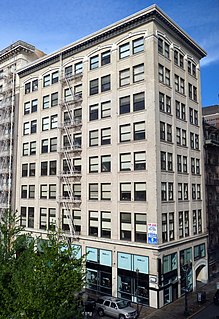
The Woodlark Building is a historic commercial building in downtown Portland, Oregon, United States that is listed on the National Register of Historic Places. The nine-story building was designed by Doyle, Patterson & Beach, and constructed in 1911–12. It has been described as "one of Portland's earliest commercial skyscrapers". From its completion until 1924, it was the headquarters of two jointly owned and very similarly named pharmaceutical companies based in Portland, the retail Woodard, Clarke & Company, and the wholesale Clarke-Woodward Company. It was converted into an office building in 1924. The retail space on the ground floor, mezzanine and basement has held a variety of businesses, in succession over the building's history, among the longest-lasting ones being a drugstore (1912–1927), a Sherman Clay piano and music store (1930–1974), and an independent shoe store (2000–2016).

The Chieftain Hotel is a historic former hotel building at 38 Pearl Street in Council Bluffs, Iowa, United States. It opened in 1927, the result of a partnership between the Eppley Hotel Company and local patrons, and was built on the site of the Grand Hotel, which had opened in 1891 and was destroyed by a fire in 1925. The hotel was eight stories tall, and featured 153 guest rooms.






